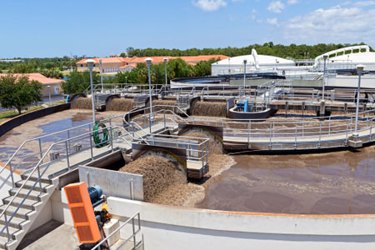Bio-Organic Flocculant Treatment For Phosphorus Removal: A Zeoturb Case Study

Problems with Phosphorus in Wastewater
Regulating the discharge of phosphorus from industrial and municipal wastewater treatment plants is a primary factor in averting the eutrophication of surface water sources. Phosphorus is one of the key nutrients that contribute to this process in both lakes and natural waters. Its existence has caused major water quality issues such as the diminished recreational value of these surface waters, increased water treatment costs as well as the potentially lethal consequences of mycotoxins from algal growth.
For example, wastewater from municipal wastewater utility plants can contain from 4 to 21 mg/l of total phosphorus, with 1-4 mg/l organic and the rest inorganic. The respective contribution can increase, due to phosphorus being one of the main components of some synthetic detergents.
In a household, for instance, phosphorus contribution can vary between 0.66 and 4.85 g/inhabitant per day with an average of about 2.15 g. The typical types of phosphorus found in wastewater solutions encompass:
- Polyphosphates: molecules with 2 or more phosphorus atoms. Typically reverts to orthophosphate under a slow process.
- Orthophosphate: molecules with 1 phosphorus atom
Typical conventional chemical treatments allow an excess of phosphorus to be discharged in the final effluent, causing eutrophication in surface waters. New regulations are restricting phosphorus limits to reduce these issues.
Bio-Organic Flocculant Treatment for Phosphate Removal in Urban WWTPs plants
Phosphate removal is currently achieved largely through chemical precipitation by conventional metal salts or synthetic polymers in urban wastewater treatment plants (WWTP). This practice is expensive and causes an increase of sludge volume by up to 40%.
A sustainable alternative is utilizing bio-organic flocculant treatment for phosphate treatment such as Zeoturb liquid bio-organic flocculant. In this case, there is no addition of capital costs (CAPEX) as the same liquid chemical feed systems and mixers used for conventional treatments can be employed.
Additionally, utilizing Zeoturb can provide additional operating advantages including the reduction of sludge volume, easier dewatering, and significantly lower sludge transport costs.
Using Bio-Organic Flocculants with Specialized Electrocoagulation for Small Decentralized WWTPs
Phosphate releases either through sewage effluent or agriculture runoff also are issues occurring in smaller communities across the US and around the world. In many cases, these communities do not have wastewater treatment systems that are sufficiently equipped to effectively reduce phosphate levels prior to discharge. This leads to unabated eutrophication issues causing lasting effects on local ecosystems.
In smaller communities, decentralized modular systems incorporating specialized electrochemical treatment and bio-organic flocculants can be key to reducing phosphate levels. This can allow both companies and utilities to manage their treatment effectively to meet discharge requirements and limit any effects of eutrophication on the surrounding ecosystems.
The integration of a GWT specialized EC with post clarification utilizing Zeoturb liquid bio-organic flocculant technology can provide the advantages of phosphate recovery to meet discharge requirements and limit the damaging effects of eutrophication in receiving surface water bodies.
Recovering phosphate from WWTP effluent can have high value, and given this particular innovative solution it is logistically and economically feasible to implement these modular treatment solutions for small communities and industrial companies to alleviate the effects of elevated phosphorus release into the local ecosystems across the US and around the world.
Interested to learn more about how Zeoturb bio-organic liquid flocculant can help your organization with sustainable phosphate removal? Contact the water & wastewater treatment experts at Genesis Water Technologies, Inc. +1 321 280 2742 or reach out to us via email at customersupport@genesiswatertech.com to discuss your specific situation.
Application Case Study – (Municipal Wastewater Phosphate Treatment)
Challenge
A large municipal water utility was having issues treating their secondary wastewater to meet phosphorus discharge regulations at several of their wastewater treatment plants. They were looking to implement a sustainable solution to treat this wastewater to comply with regulatory requirements while minimizing any impact of eutrophication in the local ecosystems.
- PO4 (Phosphate)
- Influent Wastewater: 12.1 mg/l avg.
- Effluent Wastewater (Regulated): <4 mg/l regulatory limit
Solution
Genesis Water Technologies worked with the municipal client to conduct a treatability analysis of our NSF-certified Zeoturb liquid bio-organic flocculant for the removal of phosphate in the domestic wastewater source. The objective was to meet the regulatory limit of phosphorus using a sustainable solution while optimizing operating costs.
Following this treatability analysis and successful results, the Zeoturb bio-organic flocculant would be introduced at the optimized dosing rates obtained through this testing analysis.
Results
The phosphorus levels obtained during treatability analysis met the required discharged limits post-treatment. Implementation of treatment at full scale in these wastewater treatment plants is ongoing.
Treated PO4 ranged from 85-93% reduction to levels from 0.8-1.8 which is well within regulatory limits.
Capital cost and operation cost were minimized in this process as the chemical feed systems are already existing and sludge production was minimized with solids sludge easily dewatered. Additionally, significantly lower sludge transport costs as sludge volumes are reduced and sludge is able to be land applied without hazmat restrictions.
